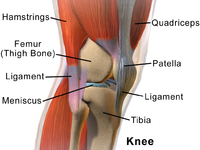
Photo from wikipedia
To investigate the associations of systolic blood pressure (SBP) and diastolic blood pressure (DBP) with changes in knee cartilage composition and joint structure over 48 months, using magnetic resonance imaging… Click to show full abstract
To investigate the associations of systolic blood pressure (SBP) and diastolic blood pressure (DBP) with changes in knee cartilage composition and joint structure over 48 months, using magnetic resonance imaging (MRI) data from the Osteoarthritis Initiative (OAI). A total of 1126 participants with right knee Kellgren-Lawrence (KL) score 0–2 at baseline, no history of rheumatoid arthritis, blood pressure measurements at baseline, and cartilage T2 measurements at baseline and 48 months were selected from the OAI. Cartilage composition was assessed using MRI T2 measurements, including laminar and gray-level co-occurrence matrix texture analyses. Structural knee abnormalities were graded using the whole-organ magnetic resonance imaging score (WORMS). We performed linear regression, adjusting for age, sex, body mass index, physical activity, smoking status, alcohol use, KL score, number of anti-hypertensive medications, and number of nonsteroidal anti-inflammatory drugs. Higher baseline DBP was associated with greater increases in global T2 (coefficient 0.22 (95% CI 0.09, 0.34), P = 0.004), global superficial layer T2 (coefficient 0.39 (95% CI 0.20, 0.58), P = 0.001), global contrast (coefficient 15.67 (95% CI 8.81, 22.53), P < 0.001), global entropy (coefficient 0.02 (95% CI 0.01, 0.03) P = 0.011), and global variance (coefficient 9.14 (95% CI 5.18, 13.09), P < 0.001). Compared with DBP, the associations of SBP with change in cartilage T2 parameters and WORMS subscores showed estimates of smaller magnitude. Higher baseline DBP was associated with higher and more heterogenous cartilage T2 values over 48 months, indicating increased cartilage matrix degenerative changes.
Journal Title: Skeletal Radiology
Year Published: 2020
Link to full text (if available)
Share on Social Media: Sign Up to like & get
recommendations!